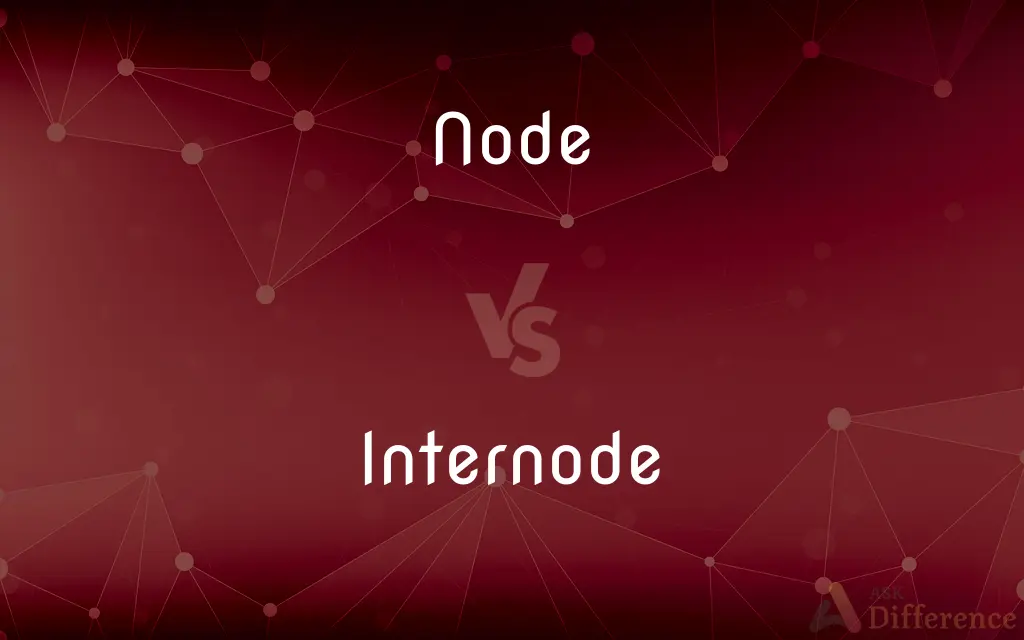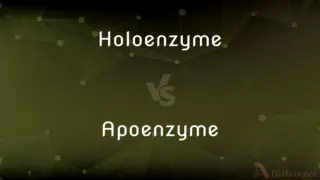Node vs. Internode — What's the Difference?
By Tayyaba Rehman & Urooj Arif — Updated on March 20, 2024
A node is the point on a plant stem where leaves or branches originate, while an internode is the segment of stem between two nodes.

Difference Between Node and Internode
Table of Contents
ADVERTISEMENT
Key Differences
In botany, a node refers to the specific point along a plant stem where leaves, branches, buds, or aerial roots originate. It's a critical part of the plant's growth and development structure. On the other hand, an internode is the stem segment that lies between two successive nodes. It plays a vital role in the plant's height and space distribution among leaves and branches.
Nodes are often sites of significant biological activity within the plant, including the formation of new leaves or flowers. This contrasts with internodes, which are primarily associated with elongation and support, providing the plant with structural integrity and the ability to spread its leaves for optimal light absorption.
The length and characteristics of internodes can vary greatly among different plant species and even within a single plant, influenced by environmental conditions and genetic factors. In contrast, nodes are generally consistent in their function across different plant species, serving as critical points for new growth and development.
The density and distribution of nodes and internodes play a crucial role in the plant's overall form and architecture. Dense nodes can lead to bushier growth, while elongated internodes can result in a taller, more spread-out plant structure. This balance is crucial for various plant functions, including reproduction, photosynthesis, and nutrient transport.
Comparison Chart
Definition
Point on a stem where leaves or branches originate
Segment of stem between two nodes
ADVERTISEMENT
Function
Support for leaves, flowers, and new branches
Provides stem elongation and spacing for leaves
Biological Activity
High, with potential for new growth and reproduction
Primarily structural, with less direct biological activity
Variation
Consistent function across species
Length varies greatly among species and environmental conditions
Role in Plant Architecture
Determines the arrangement of leaves and branches
Influences plant height and leaf distribution
Compare with Definitions
Node
A junction on a plant stem where leaves are attached.
Nodes can be easily identified by the presence of leaf scars.
Internode
The stem portion between two nodes.
Internodes are longer in plants that are spaced out for better light absorption.
Node
Nodes are critical for the growth of new stems or flowers.
Flower buds typically form at the nodes of plants.
Internode
Internode length can be influenced by light exposure.
Plants in low light may have elongated internodes.
Node
The number of nodes can indicate the age of certain plant parts.
Counting nodes can help determine vine maturity.
Internode
In some plants, internodes can store nutrients.
Sugarcane internodes are rich in sugar content.
Node
Nodes can vary in appearance across different plant species.
In bamboo, nodes are prominently visible as ring-like structures.
Internode
Pruning can affect internode length in subsequent growth.
Pruning can lead to shorter internodes and bushier plants.
Node
A knob, knot, protuberance, or swelling.
Internode
Internodes provide structural support to plants.
Sturdy internodes help plants stand upright and support leaves.
Node
(Medicine) A small, well-defined mass of tissue that is either normal or pathological, as a lymph node or a node at an arthritic joint.
Internode
A section or part between two nodes, as of a nerve or stem.
Node
A point or area where two lines, paths, or parts intersect or branch off
"The nodes, or branching points, are usually demarcated by sets of one or more new, evolutionary characters that typify all taxa" (Pat Shipley).
Internode
Between nodes.
Node
A focal point or a point of interaction
"Inside the hospital, she became a node of gossip, despite being unable to communicate in the usual way" (Oliver Sacks).
Internode
(botany) A section of stem between two stem nodes.
Node
(Botany) The point on a stem where a leaf is attached or has been attached; a joint.
Internode
(technical) Whatever lies between two nodes.
Node
See knot1.
Internode
The space between two nodes or points of the stem from which the leaves properly arise.
Node
(Physics) A point or region of virtually zero amplitude in a wave or periodic system.
Internode
A part between two joints; a segment; specifically, one of the phalanges.
Node
(Mathematics) The point at which a continuous curve crosses itself.
Internode
A segment of a stem between two nodes
Node
(Computers) A terminal in a computer network.
Node
Either of two diametrically opposite points at which the orbit of a planet intersects the ecliptic.
Node
Either of two points at which the orbit of a satellite intersects the orbital plane of a planet.
Node
A knot, knob, protuberance or swelling.
Node
(astronomy) The point where the orbit of a planet, as viewed from the Sun, intersects the ecliptic. The ascending and descending nodes refer respectively to the points where the planet moves from South to North and N to S; their respective symbols are ☊ and ☋.
Node
(botany) A leaf node.
Node
(networking) A computer or other device attached to a network.
Node
(engineering) The point at which the lines of a funicular machine meet from different angular directions; — called also knot.
Node
(geometry) The point at which a curve crosses itself, being a double point of the curve. See crunode and acnode.
Node
(geometry) A similar point on a surface, where there is more than one tangent-plane.
Node
(graph theory) A vertex or a leaf in a graph of a network, or other element in a data structure.
Node
(medicine) A hard concretion or incrustation which forms upon bones attacked with rheumatism, gout, or syphilis; sometimes also, a swelling in the neighborhood of a joint.
Node
(physics) A point along a standing wave where the wave has minimal amplitude.
Node
(rare) The knot, intrigue, or plot of a dramatic work.
Node
(technical) A hole in the gnomon of a sundial, through which passes the ray of light which marks the hour of the day, the parallels of the Sun's declination, his place in the ecliptic, etc.
Node
(computational linguistics) The word of interest in a KWIC, surrounded by left and right cotexts.
Node
(electronics) A region of an electric circuit connected only by (ideal) wires (i.e the voltage between any two points on the same node must be zero).
Node
A knot, a knob; a protuberance; a swelling.
Node
One of the two points where the orbit of a planet, or comet, intersects the ecliptic, or the orbit of a satellite intersects the plane of the orbit of its primary.
Node
A special point in a graph or diagram which is attached to other points by links. It is often labeled and represented graphically as a box or circle. A node may represent any object which is related to other objects in a conceptual structure that can be represented as a graph, the relations being represented as links between the nodes.
Node
A small mass of tissue differing from other tissue in its immediate vicinity; as, a lymph node.
Node
A connecting point at which several lines come together
Node
Any thickened enlargement
Node
(physics) the point of minimum displacement in a periodic system
Node
(astronomy) a point where an orbit crosses a plane
Node
The source of lymph and lymphocytes
Node
Any bulge or swelling of an anatomical structure or part
Node
(computer science) any computer that is hooked up to a computer network
Common Curiosities
Can nodes and internodes be used to identify plant species?
Yes, the characteristics and arrangement of nodes and internodes can help in plant identification.
Do all plants have clearly defined nodes and internodes?
Most vascular plants have nodes and internodes, but their prominence can vary significantly.
Are nodes only found on stems?
Primarily, yes, but similar structures can also be found where leaves or other organs attach to roots or other parts of the plant.
Can the number of nodes affect fruit production?
Yes, in many fruiting plants, the number of nodes can influence the potential number of flowers and, consequently, fruits.
How do nodes and internodes adapt in climbing plants?
In climbers, nodes may produce tendrils or other structures for support, while internodes allow for the necessary reach and flexibility.
What determines the length of an internode?
Internode length is influenced by genetic factors, environmental conditions, and plant health.
How do nodes respond to damage or injury?
Nodes can become active growth points in response to injury, initiating the growth of new shoots or leaves.
How do environmental factors like light and water affect nodes and internodes?
Adequate light tends to shorten internodes by promoting more node formation, while water stress can affect the growth and development of both.
Do nodes and internodes have different roles in nutrient transport?
Their roles are complementary; while nodes may be sites for nutrient storage and utilization, internodes contribute to the overall transport system in the stem.
How does pruning affect nodes and internodes?
Pruning can stimulate new growth at nodes and may result in shorter internodes in new growth, leading to denser foliage.
Can internode length be manipulated for agricultural purposes?
Yes, through breeding, pruning, and environmental control, farmers can influence internode length to optimize crop yields and manage plant size.
Is there a correlation between internode length and plant height?
Generally, plants with longer internodes tend to be taller, assuming similar node counts, as each internode contributes to the stem's length.
Can the presence of nodes and internodes impact photosynthesis?
Indirectly, yes. The arrangement and length of internodes can affect leaf spacing and orientation, which in turn influences light capture and photosynthesis.
Share Your Discovery

Previous Comparison
Prosecutor vs. Defendant
Next Comparison
Holoenzyme vs. ApoenzymeAuthor Spotlight
Written by
Tayyaba RehmanTayyaba Rehman is a distinguished writer, currently serving as a primary contributor to askdifference.com. As a researcher in semantics and etymology, Tayyaba's passion for the complexity of languages and their distinctions has found a perfect home on the platform. Tayyaba delves into the intricacies of language, distinguishing between commonly confused words and phrases, thereby providing clarity for readers worldwide.
Co-written by
Urooj ArifUrooj is a skilled content writer at Ask Difference, known for her exceptional ability to simplify complex topics into engaging and informative content. With a passion for research and a flair for clear, concise writing, she consistently delivers articles that resonate with our diverse audience.














































